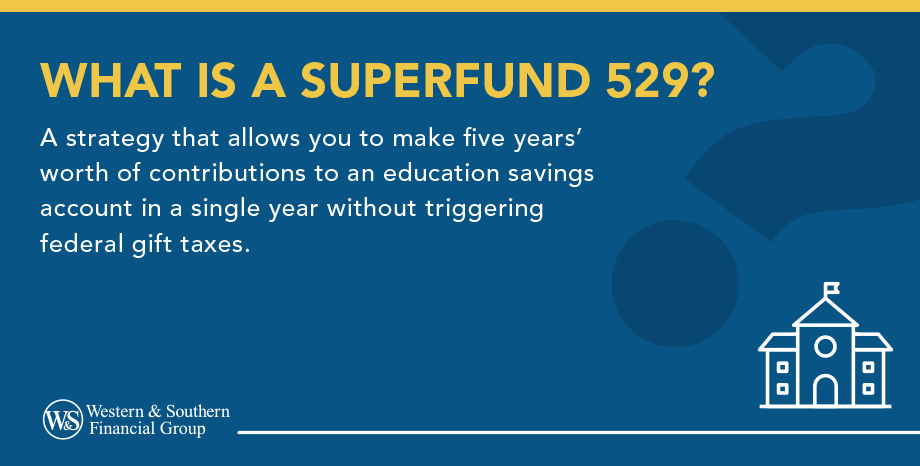

Key Takeaways
- A Superfund 529 plan lets you contribute up to five years of gifts at once without triggering federal gift taxes.
- In 2025, individuals can contribute up to $95,000 - and married couples up to $190,000 - to a 529 plan using this strategy.
- You must file IRS Form 709 to elect five-year gift averaging, even though no gift tax is due.
- After superfunding, you can’t make more tax-free gifts to the same beneficiary for five years unless you use your lifetime gift exemption.
- Superfunding can grow your education savings faster, potentially reduce your estate tax burden, and support long-term wealth transfer goals.
When it comes to college savings and estate planning, the Superfund 529 plan strategy is one way families may accelerate their savings through upfront contributions. You can front-load five years of gifts into a single tax-free contribution, preserving more of your estate.
Whether you’re a parent, grandparent, or guardian, understanding how superfunding works could help you create a lasting educational legacy and reduce your federal estate tax burden.
What Is a Superfund 529 Plan?
At its core, a Superfund 529 plan isn’t a separate kind of account - it’s a powerful tool for front-loading contributions to a 529 plan. Rather than making a traditional annual contribution, the IRS allows you to contribute up to five years’ worth of the annual gift exclusion into a 529 account all at once - without triggering gift tax consequences.
This special tax provision is called the 5-Year Election, and it’s designed to let families take advantage of market growth, early asset allocation, and more time for tax-deferred growth.
For 2025, the gift tax exclusion amount is $19,000 per recipient ($38,000 for married couples), adjusted by inflation. That means:
- Single contributors can superfund up to $95,000 in one year
- Married couples can superfund up to $190,000 in one year
This upfront contribution not only helps maximize potential for growth over time - it potentially reduces your taxable estate, supports your educational planning goals, and can be part of a longer-term financial strategy.
Step-by-Step: How Superfunding a 529 Plan Works
This contribution strategy uses gift tax averaging - spreading one large contribution over five years for tax purposes. Here’s how to apply this excellent strategy step by step.
Step 1: Check the Current Gift Tax Exclusion Limits
Before starting, verify the IRS's federal gift exclusion amount for the year. Multiply that by five to calculate your superfunding cap per beneficiary. Staying under this threshold helps you avoid making a taxable gift.
These annual contribution limits play a critical role in determining your contribution amounts and maintaining compliance.
Step 2: Make a Lump-Sum Contribution
Once you’ve confirmed the limits, contribute the full annual contribution x 5 amount to the 529 college savings plan. These education savings plans are among the most tax-advantaged accounts available for meeting college expenses.
529 plans can be used for a wide range of educational expenses, including prepaid tuition plans, K-12 education, college, graduate school, and even trade schools - so long as the institution qualifies as an eligible educational institution.
Tip
You can superfund multiple 529 accounts for different children or grandchildren, staying within contribution limits for each.
Step 3: File IRS Form 709 (Gift Tax Return)
Even though no tax is due, filing IRS Form 709 is mandatory. It lets you elect to spread the gift over five years - the cornerstone of gift tax averaging.
On the form, you'll:
- Report the plan contributions
- Elect five-year treatment
- Provide details on the educational institution, beneficiary, and donor
This form also documents your use of the gift exclusion, a crucial step if you’re tracking use of your lifetime gift tax exemption.
Step 4: Refrain from Additional Gifts to the Same Beneficiary
Once you superfund, you can’t give that same beneficiary additional tax-free gifts for five years without exceeding the annual limit - unless you're willing to tap into your lifetime gift and estate tax exemption.
Consider this when coordinating broader estate planning strategies or generation-skipping transfer tax planning for grandchildren.
Step 5: Monitor the 529 Account's Investment Performance
Account owners retain control over investment decisions and can adjust based on changing market conditions. Most plans offer a range of investment options, including mutual funds, age-based portfolios, and target-date strategies.
This flexibility makes 529 plans similar to other investment accounts, with the added benefit of tax-free growth for education.
Step 6: Use Funds for Qualified Expenses
You can withdraw the funds tax-free when used for qualified education expenses, such as:
- Tuition and fees
- Room and board (for half-time or full-time students)
- Books, supplies, and laptops
- K-12 tuition (up to $10,000 per year)
Withdrawals for non-qualified expenses are subject to income tax and a 10% penalty on the earnings portion - undermining the income tax benefits these accounts offer.
Step 7: If Plans Change, Reassign or Roll Over
If the original beneficiary doesn’t need the funds, you can:
- Change the beneficiary to another eligible family member
- Roll unused funds into a Roth IRA (subject to conditions, up to $35,000)
- Keep the account active for future educational plans
- Withdraw the funds (penalties apply on earnings if not used for qualified expenses)
Important Requirements:
- You must file IRS Form 709 the year you superfund
- You must elect to spread the gift over five years
- No additional gifts can be made to the same beneficiary during that five-year period without exceeding the exclusion
This method allows you to stay within gift tax exclusions while maximizing contributions.
Pros & Cons of Superfunding a 529 Plan
| Pros | Cons |
|---|---|
| Avoids triggering federal gift tax | Requires IRS Form 709 filing |
| Reduces taxable estate | Restricts additional contributions to that beneficiary for 5 years |
| Allows maximum compound growth potential early on | Could affect financial aid eligibility |
| Offers flexibility for estate planning and Generation-Skipping Transfer benefits | Tied to market performance and investment strategy choices |
| Can be used for K-12 education, college, or grad school expenses | Funds must be used for qualified expenses to avoid penalties |
| Often offers state tax deductions for plan contributions | Limited to contribution limits set by state or plan provider |
Why Consider Superfunding?
This strategy combine college savings strategies with smart wealth transfer planning.
- Accelerated Growth: More time in the market = potentially more compound growth. Starting early gives 529 college savings plans room to grow tax-free.
- Estate Planning: Superfunding helps remove assets from your estate - without exceeding your gift tax exclusion amount. It's an excellent strategy for anyone looking to reduce estate tax exposure while investing in their family's future.
- Education Legacy: Grandparents often use superfunding as part of a broader financial strategy to meet educational goals and pass on wealth in a meaningful way.
Tax Benefits of Superfunding
Here's how this strategy leverages the Internal Revenue Code:
- No federal income tax on earnings if used for Qualified Higher Education Expenses
- No federal gift tax if contributions remain within the annual gift tax exclusion averaged over five years
- Reduces your taxable estate, which may help avoid estate tax
- Some states offer state income tax deductions or credits for 529 plan contributions, though these benefits often apply only to contributions made to your home state's 529 plan.
It also complements other education savings plans like Coverdell accounts and prepaid options, depending on your financial needs.
How Superfunding Affects Financial Aid
Under recent changes from the FAFSA Simplification Act, the treatment of 529 plans is more favorable. A student- or parent-owned 529 is reported as a parental asset, which has a minimal impact on financial aid eligibility.
Distributions from a 529 plan owned by a grandparent or other third party are no longer reported as student income on the FAFSA, removing a significant financial aid trap that existed under the old rules
Superfunding vs. Other Education Strategies
| Feature | Superfunded 529 Plan | Coverdell ESA |
|---|---|---|
| Primary Purpose | Education savings | Education savings |
| Tax-Free Withdrawals | Yes, for qualified expenses | Yes, for qualified expenses |
| Contribution Limits | $90k&-$180k (via superfunding) | $2,000/year per beneficiary |
| Financial Aid Impact | Depends on account ownership | Treated as parental asset |
| Investment Options | Wide range of mutual funds and portfolios | Limited options |
| Annual Contribution Limits | High (via superfunding) | Low |
Roth IRAs provide more flexibility for retirement, but 529 plans, especially when superfunded, maximize education-specific tax benefits.
Who Should Consider Superfunding?
You might benefit from superfunding if you:
- Want to maximize education savings plans with early investment accounts
- Are pursuing wealth transfer or estate reduction strategies
- Are financially able to front-load education gifts
- Prefer a hands-on approach to investment choices and account control
- Want to support multiple generations with smart college savings strategies
It’s particularly appealing to high-net-worth individuals, married couples, and those using a financial advisor for multi-year planning.
Tips for Making the Most of Superfunding
Superfunding a 529 plan is a potent education strategy that requires thoughtful execution. Whether you’re parent, grandparent, or a high-net-worth individual incorporating it into a wealth transfer plan, these tips will help you maximize this tax-advantaged savings.
- Work with a financial advisor to build a comprehensive contribution strategy. A financial advisor can help align your contribution strategy with your financial goals while ensuring IRS tax compliance and seamlessly superfunding with other activities like charitable giving or estate planning.
- Align with your broader educational planning or retirement goals. Combine superfunding with your educational and retirement plans. Decide if you’re focusing on K-12, supporting grandkids, or college savings. Explore Coverdell ESAs, prepaid tuition, or custodial accounts to suit your family’s needs.
- Monitor and adjust investment choices based on market trends and risk tolerance. 529 plans offer diverse investment choices, requiring active oversight due to market risks. As college approaches, shifting to conservative allocations may minimizes losses. Regularly asset allocations to protect value and align with risk tolerance and market trends.
- Stay within annual exclusions and contribution limits. Keep track of annual exclusions, contribution limits, and gift tax rules to meet IRS requirements. State-specific 529 plan limits vary. Exceeding these may trigger taxable gifts or impact your lifetime gift tax exemption. Understanding these figures aids in balancing superfunding with other gifts for beneficiaries or charities.
- Use tax tools like Form 709 correctly to avoid unintended gift tax consequences. Correct filing of IRS Form 709 is essential, even if taxes aren't owed. It records the 5-Year Election to distribute contributions. Mistakes can lead to gift tax problems. Seek professional advice if extra contributions to the same beneficiary are made within five years to prevent exceeding limits or incurring gift taxes.
Final Thoughts
Superfunding a 529 plan blends high-impact education savings with tax-smart estate planning. It’s one of the few strategies where families can give generously, grow assets tax-free, and reduce future estate taxes - all with one move.
But it’s not for everyone. Superfunding requires upfront capital, clear long-term goals, and attention to IRS rules. For those in a position to use it, though, it’s a powerful legacy tool that can rethink how families cover education costs - without sacrificing financial control.
Consider a Superfund 529 plan to help maximize your education savings. Invest Today
Frequently Asked Questions
Can grandparents superfund a 529 plan?
Can both parents superfund a 529 plan for the same child?
Can you superfund an existing 529 plan?
What age is too late to superfund a 529 plan?
Sources
- Gift Tax - Internal Revenue Service. https://www.irs.gov/businesses/small-businesses-self-employed/gift-tax.
- 529 Plans: Questions and Answers - Internal Revenue Service. https://www.irs.gov/newsroom/529-plans-questions-and-answers.
- Publication 970: Tax Benefits for Education - Internal Revenue Service. https://www.irs.gov/forms-pubs/about-publication-970.
- Instructions for Form 709 - Internal Revenue Service. https://www.irs.gov/instructions/i709.
- Understanding the Gift Tax - Legal Information Institute, Cornell Law School. https://www.law.cornell.edu/wex/gift_tax.
- Saving for College with a 529 Plan - U.S. Securities and Exchange Commission (SEC). https://www.sec.gov/reportspubs/investor-publications/investorpubsintro529htm.html.



























